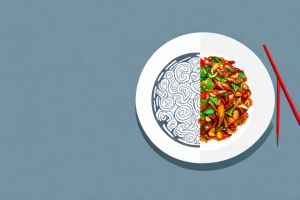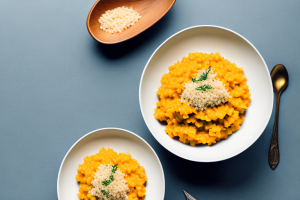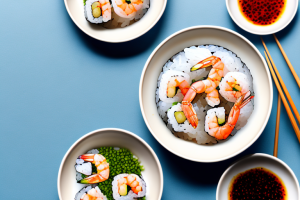How to cook brown rice with lentils and roasted vegetables
8 min read
A bowl of cooked brown rice
Are you looking for a healthy, nutritious, and easy-to-make meal? Look no further than brown rice with lentils and roasted vegetables! In this article, we will guide you through the process of making this hearty and wholesome dish, including tips on how to choose the best ingredients, how to properly prepare them, and how to cook them to perfection. So let’s get started!
The health benefits of brown rice, lentils, and roasted vegetables
Before we dive into the recipe, let’s take a look at the health benefits of the main ingredients in this dish.
Brown rice is a whole grain that is naturally rich in fiber, vitamins (including B vitamins), and minerals (such as magnesium and selenium). It also has a lower glycemic index than white rice, which means it can help regulate blood sugar levels.
Lentils are also a great source of fiber, protein, and various other nutrients (such as iron and folate). They have a low glycemic index as well, which makes them a good choice for people with diabetes or those looking to manage their blood sugar levels.
Finally, roasted vegetables are packed with vitamins, antioxidants, and fiber. When roasted, they become tender and slightly caramelized, which enhances their natural sweetness and flavor.
In addition to their nutritional benefits, brown rice, lentils, and roasted vegetables are also great for weight management. They are low in calories and high in fiber, which can help you feel full and satisfied for longer periods of time. This can lead to a reduction in overall calorie intake and ultimately, weight loss.
Furthermore, these ingredients are versatile and can be used in a variety of dishes. Brown rice can be used as a base for stir-fries or salads, lentils can be added to soups or stews, and roasted vegetables can be used as a side dish or added to sandwiches and wraps. Incorporating these ingredients into your diet can help you add variety and flavor to your meals while also reaping their health benefits.
The different types of lentils and how to choose the best ones for your dish
There are many different types of lentils available, including brown, green, yellow, and red lentils. Each type has a slightly different texture and flavor profile, so it’s important to choose the right one for your dish.
For this recipe, we recommend using brown lentils, as they hold their shape well when cooked and have a slightly nutty and earthy flavor that pairs well with the other ingredients.
When choosing lentils, make sure to check for any signs of damage or decay, and rinse them thoroughly before cooking.
It’s also worth noting that different types of lentils have varying cooking times. Brown and green lentils typically take longer to cook than red and yellow lentils, which can become mushy if overcooked. So, if you’re using a different type of lentil for your dish, be sure to adjust the cooking time accordingly.
How to properly prepare brown rice for cooking
Before cooking brown rice, it’s important to rinse it thoroughly to remove any dirt or debris. You can also soak the rice for a few hours or overnight, which can help improve its digestibility and reduce cooking time.
The ratio of liquid to rice for cooking brown rice is typically 2:1 (two cups of water or broth for every cup of rice). Bring the liquid to a boil in a saucepan, add the rice, stir, and then reduce the heat to low and cover the pan with a lid. Cook for about 40-50 minutes, or until the rice is tender and all the liquid has been absorbed.
Once the rice is cooked, it’s important to let it sit for a few minutes before fluffing it with a fork. This allows the rice to absorb any remaining liquid and ensures that it’s evenly cooked. Additionally, you can add some flavor to your brown rice by cooking it in broth instead of water, or by adding herbs and spices to the cooking liquid.
The benefits of soaking brown rice and lentils before cooking
Soaking brown rice and lentils before cooking can help improve their texture, flavor, and nutrient availability. When soaked, the grains and legumes absorb water and begin to germinate, which activates enzymes that break down starches and other complex molecules.
This process not only makes the grains and legumes easier to digest, but it can also increase their nutrient content and reduce cooking time. Soaking brown rice and lentils overnight is ideal, but even a few hours can make a difference.
In addition to the benefits mentioned above, soaking brown rice and lentils can also help remove phytic acid, which is a compound that can bind to minerals in the body and prevent their absorption. By soaking the grains and legumes, the phytic acid is broken down, making the minerals more available for the body to use.
Tips for roasting vegetables to perfection
Roasting vegetables is one of the easiest and most flavorful ways to prepare them. Here are some tips to ensure that your roasted vegetables turn out perfectly every time:
- Choose vegetables that are firm and fresh
- Cut them into similar-sized pieces for even cooking
- Toss them with a bit of oil, salt, and pepper to enhance their natural flavors
- Spread them out evenly on a baking sheet and roast at a high temperature (around 400-425°F) until tender and slightly browned
- Rotate the pan halfway through cooking to ensure even browning
Another important tip for roasting vegetables is to not overcrowd the baking sheet. If the vegetables are too close together, they will steam instead of roast, resulting in a mushy texture and less flavor. It’s better to use two baking sheets if necessary, to ensure that the vegetables have enough space to roast properly. Additionally, you can experiment with different herbs and spices to add more depth of flavor to your roasted vegetables. Some popular options include garlic, rosemary, thyme, and paprika.
The best spices and seasonings to use when cooking this dish
For this dish, we recommend using a blend of spices and seasonings that complement the natural flavors of the ingredients. Here’s a simple seasoning blend you can try:
- 1 teaspoon cumin
- 1 teaspoon paprika
- 1/2 teaspoon garlic powder
- 1/2 teaspoon onion powder
- 1/4 teaspoon black pepper
Sprinkle this seasoning blend over the lentils, rice, and roasted vegetables before serving, or use it to season the vegetables before roasting.
Another great addition to this dish is a squeeze of fresh lemon juice. The acidity of the lemon juice helps to brighten the flavors of the lentils and vegetables, while also adding a refreshing tanginess to the dish. Simply cut a lemon into wedges and serve alongside the dish, allowing each person to squeeze as much or as little lemon juice as they like over their portion.
How to cook brown rice and lentils together in one pot
Cooking brown rice and lentils together in one pot is not only convenient, but it also allows the flavors to meld together for a more delicious and wholesome dish. Here’s how to do it:
- Rinse the brown rice and lentils and soak them overnight (optional).
- In a large pot, heat a tablespoon of oil over medium heat.
- Add diced onions and sauté for a few minutes until softened.
- Add the rice, lentils, and seasoning blend, and stir to combine.
- Add four cups of water or broth, and stir again.
- Cover the pot with a lid and bring the mixture to a boil.
- Reduce the heat to low and simmer for about 40-50 minutes, or until the rice and lentils are tender and all the liquid has been absorbed.
- Stir in the roasted vegetables and serve hot.
This dish is not only delicious, but it is also packed with nutrients. Brown rice and lentils are both excellent sources of fiber, protein, and complex carbohydrates. This makes it a great option for vegetarians and vegans looking for a filling and satisfying meal. Additionally, the dish can be customized with different seasoning blends and vegetables to suit your taste preferences. Try adding some cumin and coriander for a Middle Eastern twist, or some chili powder and lime juice for a Mexican-inspired flavor. The possibilities are endless!
Different ways to serve and enjoy this dish
This dish is versatile and can be enjoyed in many different ways. Here are some ideas:
- Top the dish with fresh herbs (such as parsley or cilantro) for a pop of color and flavor.
- Add a dollop of Greek yogurt or sour cream for some creamy tanginess.
- Serve the dish with a side of pita bread or naan for a Mediterranean twist.
- Use the leftovers to make a hearty and healthy lunch bowl for the next day.
Another great way to enjoy this dish is to add some roasted vegetables, such as bell peppers or zucchini, for an extra boost of nutrients and flavor. You can also try serving it over a bed of quinoa or brown rice for a more filling meal. For a spicy kick, add some hot sauce or red pepper flakes to the dish. The possibilities are endless with this versatile and delicious recipe!
How to make this dish vegan or gluten-free
This dish is naturally vegan, but if you want to make it gluten-free, make sure to use gluten-free brown rice and double-check your seasoning blend to make sure it doesn’t contain any wheat-based ingredients.
How to meal prep and store leftovers of this dish
This dish is great for meal prep and can be stored in the fridge for up to four days. Here’s how to do it:
- Let the dish cool to room temperature.
- Divide it into individual portions and transfer to airtight containers.
- Refrigerate for up to four days.
- To reheat, simply microwave the container for 2-3 minutes or until heated through.
Nutrition facts and breakdown of the ingredients used
Here’s a breakdown of the approximate nutrition facts for one serving of this dish (based on using brown rice, brown lentils, and a mix of vegetables including carrots, bell peppers, and broccoli):
- Calories: 340
- Protein: 13g
- Carbohydrates: 62g
- Fiber: 11g
- Fat: 4g
- Sodium: 280mg
Variations on this recipe, including different types of vegetables or proteins
Feel free to get creative with this recipe and experiment with different types of vegetables or proteins. Here are some ideas:
- Try using sweet potatoes, mushrooms, or zucchini instead of broccoli or bell peppers.
- Top the dish with grilled chicken or tofu for some extra protein.
- Add some diced tomatoes or tomato sauce for a more saucy version.
- Sprinkle some feta cheese or grated Parmesan over the top for a cheesy twist.
The environmental benefits of incorporating plant-based meals into your diet
Eating plant-based meals like this one can have numerous environmental benefits, including reducing greenhouse gas emissions, conserving water and other resources, and promoting biodiversity. By choosing whole foods and reducing our reliance on animal products, we can help mitigate the impacts of climate change and contribute to a more sustainable future.
A step-by-step guide with photos on how to make this delicious, healthy meal
Congratulations, you’ve made it to the end of this article! If you’re ready to try your hand at making brown rice with lentils and roasted vegetables, check out our step-by-step guide with photos below:
By following these instructions and incorporating your own twists and variations, you can create a delicious and healthy dish that will satisfy your taste buds and nourish your body. Bon appetit!


